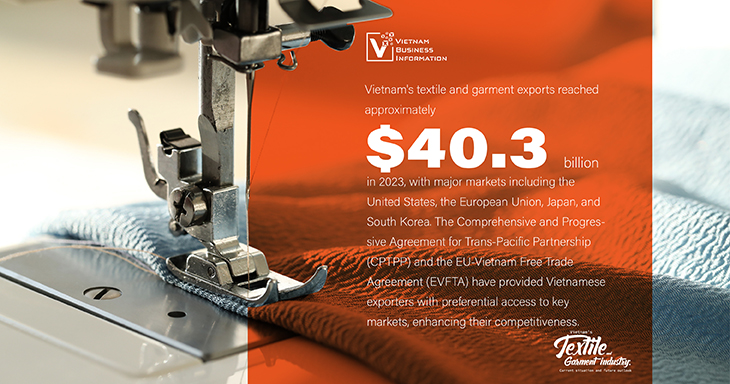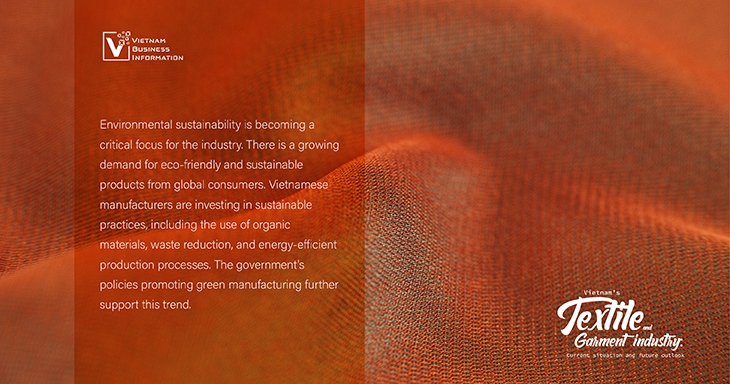Published Jun 2024
Vietnam’s textile and garment industry: current situation and future outlook
Vietnam's textile and garment industry is a cornerstone of the country's economy, contributing significantly to GDP and employment.

Current situation
Vietnam has emerged as one of the top textile and garment exporters globally, leveraging its competitive labor costs, strategic geographic location, and a network of free trade agreements (FTAs).
Vietnam's textile and garment exports reached approximately $40.3 billion in 2023, with major markets including the United States, the European Union, Japan, and South Korea. The Comprehensive and Progressive Agreement for Trans-Pacific Partnership (CPTPP) and the EU-Vietnam Free Trade Agreement (EVFTA) have provided Vietnamese exporters with preferential access to key markets, enhancing their competitiveness.

The industry is composed of various segments, including yarn, fabric, garment manufacturing, and ancillary industries like dyeing and finishing. The sector comprises over 6,000 enterprises, with a significant number being small and medium-sized enterprises (SMEs). Large state-owned enterprises (SOEs) and multinational corporations also play a crucial role, often leading in innovation and export activities.
Future outlook
The future of Vietnam's textile and garment industry looks promising, underpinned by several growth drivers and emerging trends.
Technological advancements
The adoption of advanced technologies, such as automation, digitalization, and sustainable practices, is expected to transform the industry. Companies are increasingly investing in Industry 4.0 technologies to enhance productivity, reduce costs, and improve quality. This shift towards a more technologically advanced manufacturing process is essential to maintain Vietnam's competitive edge in the global market.
Automation and digitalization
Automation and digitalization are becoming increasingly prevalent in Vietnam’s textile and garment industry. Automated machinery for cutting, sewing, and finishing processes significantly increases production efficiency and reduces labor costs. Digital technologies, such as the Internet of Things (IoT) and big data analytics, enable real-time monitoring and optimization of manufacturing processes, leading to higher product quality and operational efficiency.
Sustainable practices
Environmental sustainability is becoming a critical focus for the industry. There is a growing demand for eco-friendly and sustainable products from global consumers. Vietnamese manufacturers are investing in sustainable practices, including the use of organic materials, waste reduction, and energy-efficient production processes. The government's policies promoting green manufacturing further support this trend.

Diversification of export markets
While traditional markets like the US and EU remain vital, Vietnamese textile and garment companies are exploring new markets in regions such as Latin America, Africa, and the Middle East. This diversification strategy helps mitigate risks associated with market dependency and enhances the resilience of the industry.
Skilled workforce development
Investing in human capital is crucial for the industry's sustainable growth. Training programs and partnerships with educational institutions aim to equip the workforce with necessary skills, particularly in new technologies and sustainable practices. This focus on skill development ensures that Vietnam remains a competitive player in the global textile and garment market.
Challenges and Opportunities
Challenges
Despite its robust growth, Vietnam's textile and garment industry faces several challenges.
Rising labor costs
One of the significant challenges is the rising labor costs. As Vietnam continues to develop economically, wages are gradually increasing, which could impact the cost competitiveness of the industry. To mitigate this, companies are focusing on enhancing labor productivity through technological advancements and skill development.
Environmental regulations
Stricter environmental regulations, both domestically and internationally, are another challenge. Compliance with these regulations requires substantial investments in sustainable technologies and practices. However, this also presents an opportunity for companies to differentiate themselves in the global market by adopting eco-friendly manufacturing processes.
Supply chain disruptions
Global supply chain disruptions, exacerbated by the COVID-19 pandemic, have highlighted the vulnerability of the industry to external shocks. Diversifying suppliers and enhancing supply chain resilience are critical strategies for mitigating these risks.
Opportunities
Despite these challenges, the industry presents numerous opportunities for growth and development.
Innovation and product diversification
Innovation and product diversification are key growth drivers. Companies are increasingly focusing on high-value-added products, such as functional textiles, technical textiles, and smart textiles. These products cater to niche markets with higher profit margins and lower competition compared to traditional garment products.
E-commerce and digital marketing
The rise of e-commerce and digital marketing presents significant opportunities for Vietnamese textile and garment companies. By leveraging online platforms, companies can reach a global customer base, enhance brand visibility, and increase sales. The COVID-19 pandemic has accelerated the shift towards online shopping, making digital transformation essential for the industry's future growth.
Strategic partnerships and collaborations
Strategic partnerships and collaborations with international brands and retailers can provide Vietnamese companies with access to new markets, technologies, and best practices. These collaborations can enhance the competitiveness of Vietnamese products in the global market and drive industry growth.
Reports by Vietnam Business Information
For businesses and investors seeking detailed insights into Vietnam's textile and garment industry, Vietnam Business Information (VBI) offers comprehensive company reports and market analysis. VBI provides valuable data on market trends, competitive landscape, financial performance of key players, and strategic insights, enabling stakeholders to make informed decisions.
Our reports cover various aspects of the industry, including export-import statistics, regulatory changes, and technological advancements. By leveraging VBI’s detailed reports, businesses can identify opportunities, assess risks, and develop strategic plans tailored to the dynamic Vietnamese market.
Reference: VITAS, WTO, GSO















